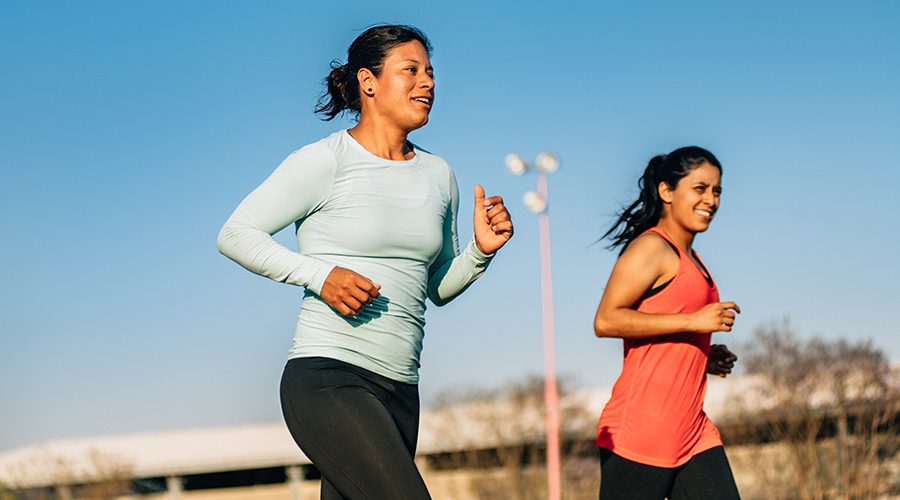Spring is calling to us to come outside and enjoy the budding trees and flowers. But if you want to reduce your risks of injury as you walk, run, bike and play, then keep in mind a few basic safety precautions.
We talked with UNC Health family and sports medicine doctor Justin A. Lee, MD, to get some tips on what you can do to enjoy being outside — and not end up in the emergency department.
The most important thing is to be aware of vehicles. More than 6,000 pedestrians and nearly 850 bicyclists were killed in traffic crashes in 2019. But there are other potential hazards, too — slippery surfaces, animals and exercise injuries among them.
This doesn’t mean you should stay inside. Just be aware and take simple precautions.
“Mostly, it’s just common sense,” Dr. Lee says, “but we all need to be reminded to pay attention to our surroundings. It’s tempting to just zone out on your run.”
1. Work with, not against, the weather.
Choose an appropriate time of day if you’re heading out for a run or brisk walk, Dr. Lee advises.
“Go out in the mornings or late afternoon and evenings,” he says. “Watch out for high heat and humidity. Find times to run when the temperature is cooler.”
Spring is notorious for storms. Check the forecast before heading out.
“It’s not dangerous to run or walk in the rain,” Dr. Lee says, “but if there’s lightning or a heavy storm, don’t go out in it.”
2. Make yourself visible.
If you are out when the sun is not, consider wearing colorful or light-colored clothes so others — especially those driving vehicles — can see you.
Reflective clothing, like vests or belts, may also help others see you sooner.
“You might want to wear a headlamp when you run,” Dr. Lee says. “It might help you see better, but it also helps alert other runners or drivers that you’re coming their way.”
3. Minimize distractions.
Lots of people like to listen to music, podcasts, books on tape or other audio while they are walking, running or biking.
“I do that myself,” Dr. Lee says, “but you also need to be aware of what’s going on around you.”
Consider keeping the volume low enough so you can hear vehicles approaching you. Don’t get so engrossed in what you’re listening to that you don’t notice others who are running, walking or riding bikes.
You also want to keep your eyes open for wild animals, fallen branches, broken sidewalks, roots or any other hazards that are common where you are. Be aware of others who may be taking the same route as you.
“You really just need to pay attention,” Dr. Lee says. “Don’t look at your phone to change the song or podcast while you are running. Make a playlist ahead of time to avoid distraction.”
4. Consider taking a buddy along.
A lot of people enjoy the company, encouragement or competition that a friend can provide.
“This may be especially important if you’re on a trail in a more secluded area,” he says.
If you find yourself confronting a wild animal or unfriendly human, another person can help reduce the risks. They also can be helpful if you get injured.
Be particularly mindful, though, if your “buddies” are children. Make rules about how far ahead a child or teen can get. Try to make sure you have enough responsible adults along to keep all the kids safe.
“Stay in familiar territory with kids,” Dr. Lee says. “Stick to your neighborhood or go to parks where there is minimal vehicle traffic. If you are on bikes and have to go on the road, try to make sure there are designated bike lanes.”
And if you see a group coming toward you, be mindful of how they are moving, including speed and direction so all of you will stay safe.
“Again, you need to pay attention, so you don’t wind up running into someone or having them run into you,” he says.
5. Good shoes — and other equipment — can help.
Properly fitting shoes, with treads appropriate for what you are doing and where, can help reduce the risks of falls or turned ankles.
“The biggest key is comfort,” Dr. Lee says. “Make sure shoes feel good on your feet and have some support.”
He suggests holding the shoe with one hand grabbing the toe, the other the heel. If you can bend the shoe like a taco, it is too flimsy. If you cannot bend the shoes too far, they should provide good support for your feet.
When you are hiking or walking on rough (nonpaved) terrain, a walking stick may be helpful for keeping your balance. A stick may even help fend off creatures who are emerging from their winter homes. Remember, they will probably be as surprised to see you as you are to see them.
Carry or wear identification, such as an ID bracelet, so that a stranger could help you and get in touch with your emergency contact if needed.
And if you are on a bike, Dr. Lee has one major rule: “Helmets, helmets, helmets!” he says. The simple act of wearing a helmet can prevent a fall from resulting in a traumatic brain injury. Learn more from the Bicycle Helmet Safety Institute.
Are you ready to start an exercise routine? Or increase your level of activity? Check with your doctor first, or find one near you.
